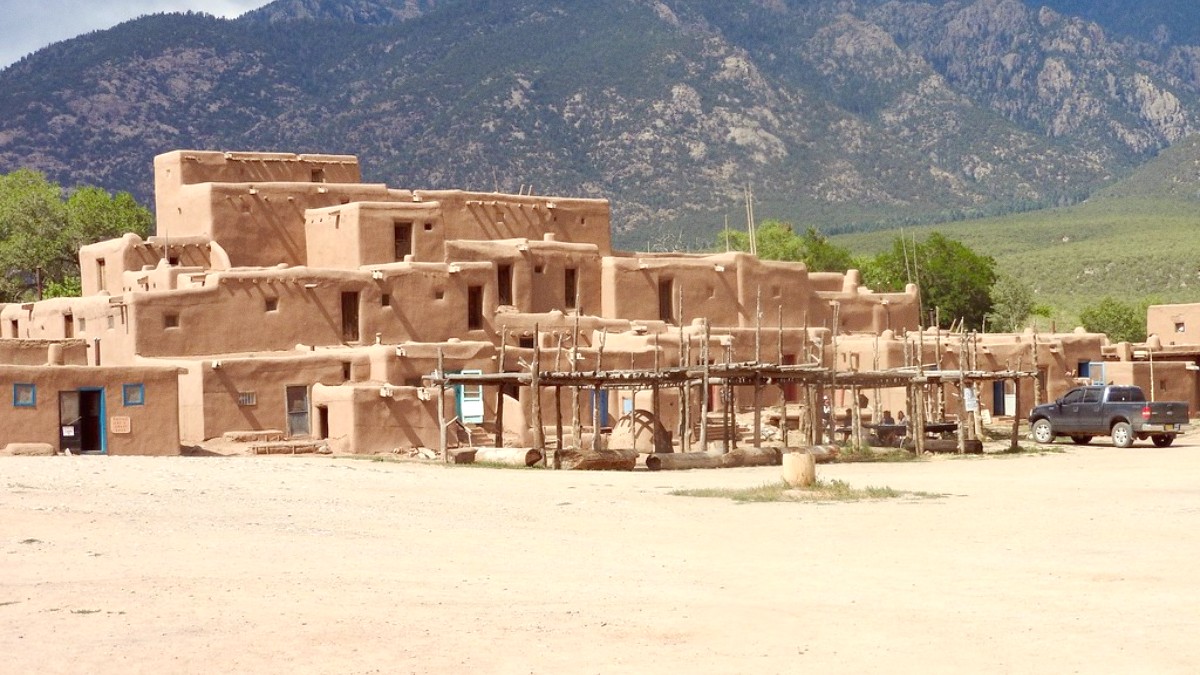
New Mexico, USA
Encounter the enduring spirit of the Pueblo people, surrounded by the powerful landscapes that have sustained them for generations.
Taos Pueblo is a distinct place in Northern New Mexico's high-desert valley, about a mile (1.6 km) north of modern Taos town. It sits at the foot of the Sangre de Cristo Mountains, a southern extension of the Rockies. These mountains create a dramatic backdrop, their peaks often snow-capped, feeding the Taos River through Pueblo lands.
The Pueblo's elevation is around 7,000 feet (2,134 meters) above sea level. This high altitude shapes the climate, with warm days under intense sun and considerably cool nights, even in summer. The dry air characterizes this high-desert environment. This setting shaped the Pueblo people's traditional life. Mountains offer protection and resources; the river waters their traditional farming. The landscape is integral to the Pueblo's identity and survival, shaping ceremonies, building materials, and daily rhythms. Vast, open skies at this elevation contribute to striking sunsets and clear, star-filled nights, adding to the region's magic.
Taos Pueblo holds an extraordinary place in history as one of North America's oldest continuously inhabited communities. People lived in its multi-story adobe structures for over 1,000 years, predating European contact by centuries. The Pueblo is home to the Red Willow people, Tiwa language speakers.
They maintain their distinct language, spiritual practices, and traditional life across countless generations, despite immense historical pressures. This continuity renders Taos Pueblo a rare and precious site. Its profound heritage saw designation as a National Historic Landmark in 1960.
One of North America's oldest continuously inhabited communities.
The native inhabitants, speakers of the Tiwa language.
Designated in 1960 for its unique heritage.
Designated in 1992 for exceptional preservation and cultural value.
Adobe buildings showing ancient building techniques.
Later, in 1992, UNESCO declared Taos Pueblo a World Heritage Site. These designations acknowledge the Pueblo's unique cultural heritage and exceptional preservation of its architectural forms.
The adobe buildings, from earth and straw, are living examples of ancient building techniques adapted over centuries. Each layer of history appears in walls, pathways, and plazas.
The Pueblo's persistence as a thriving, independent community testifies to its people's strength and adaptability. Their history lives in daily routines, ceremonies, and the quiet dignity of its people.
Visiting here means encountering this unbroken chain of human presence and culture.
Taos Pueblo extends visitors a glimpse into a living Native American community. See distinctive multi-story adobe dwellings, built in a style unchanged for centuries. These earth-built structures rise organically, reflecting the Pueblo people’s deep connection to their environment.
The Pueblo’s unique architecture, often photographed, is both practical and beautiful, adapted to the desert climate and communal society.
A place where ancient art forms like pottery and jewelry making continue to thrive.
The spiritual connection of the Pueblo people to their land is palpable.
It provides a quiet yet profound encounter with a living heritage.
The Pueblo has traditional ceremonies, though many remain private. Some feast days and events welcome visitors, a chance to observe traditional dances and rituals.